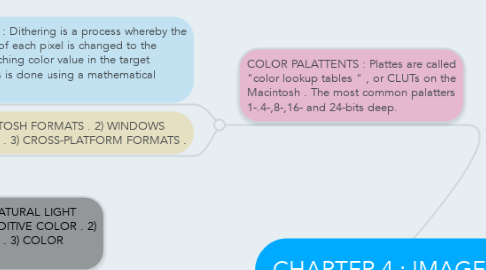CHAPTER 4 : IMAGES
by gayathiri parisamy

1. IMAGE EDITING PROGRAMS ENABLE : 1) enchance and make composite images . 2) alter and distort images. 3) add and delete elements.
1.1. VECTOR DRAWN GRAPHICS : applications of vector drawn object . How vector drawn images work . vector drawn images versus bitmaps.
2. VECTOR-DRAWN IMAGES VERSUS BITMAPS : vector images use less memory space and have a smaller file size . Vector objects are easily scalable without loss of resolution or image quality.
2.1. VERSUS BITMAPS : Vector image cannot be used for photorealistic images . vector images require a plug in for web based . Bitmaps are not easily scalable are resizable .
3. UNDERSTANDING NATURAL LIGHT AND COLOR : 1) ADDITIVE COLOR . 2) SUBRACTIVE COLOR . 3) COLOR MODELS .
3.1. ADDICITIVE COLOR : RED , GREEN ,BLUE . TV and computer monitors use this method.
3.2. SUBTRACTIVE COLOR : mix up color by using ink . EXAMPLE : printer by using the same concept . SUBTRACTIVE COLOR : when we zoom in we can see the pictures dots .
4. COLOR PALATTENTS : Plattes are called "color lookup tables " , or CLUTs on the Macintosh . The most common palatters 1-.4-,8-,16- and 24-bits deep.
4.1. DITHERING : Dithering is a process whereby the color value of each pixel is changed to the closest matching color value in the target palette. This is done using a mathematical algorithm.
4.2. 1) MACINTOSH FORMATS . 2) WINDOWS FORMATS . 3) CROSS-PLATFORM FORMATS .
5. STILL IMAGES ARE GENERATED 2 WAYS : BITMAPS AND VECTOR DRAWN GRAPHICS .
6. BITMAPS ARE IMAGE FORMAT: photo -realistic images . Complex drawings requiring fine detail.


